Family : Tingidae

Text © Prof. Santi Longo

English translation by Mario Beltramini
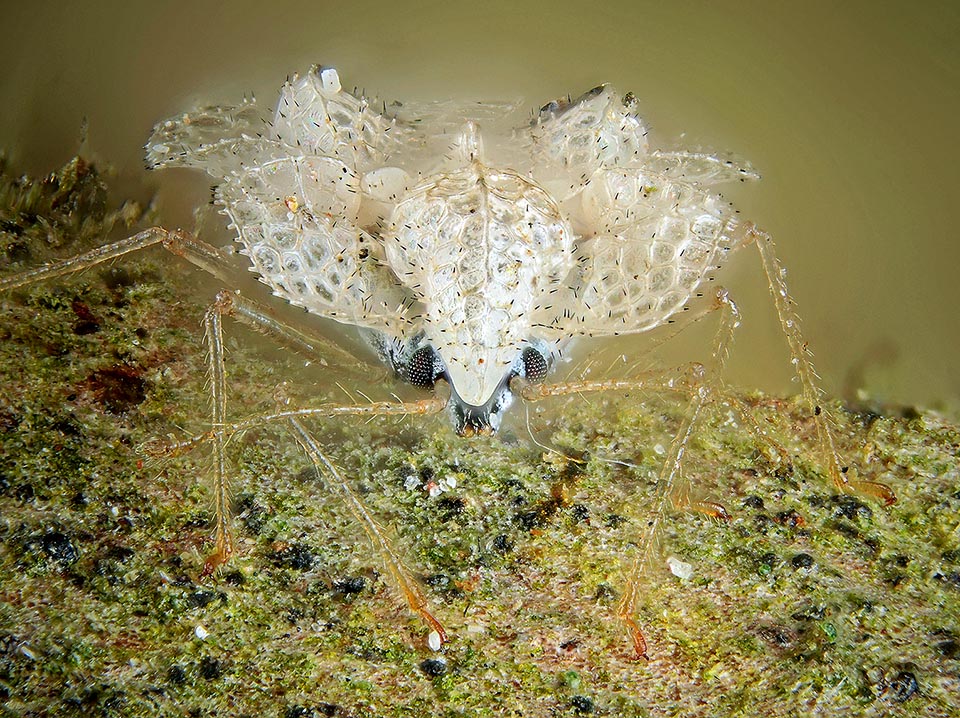
Corythucha ciliata is a species native to North America that, carried by the human activities, has invaded many regions of Eurasia and of South America © Gilles San Martin
The Platanus lace bug or Sycamore lace bug Corythucha ciliata Say, 1832, is a Rhynchote belonging to the order of the Hemiptera and of the family Tingidae that includes more than 2000 species characterized by the flattened body, by the remarkable development of the pronotum, as well as by the reticulation and semi transparency of the same and of the forewings that have a uniform consistency and are not differentiated in hemielytra.
The genus Corythucha, presently counting about 70 species, was created by Stal in 1873 and originates from the Greek “korus” (genitive “koruthos”) meaning “of the helmet” with reference to the unusual headgear.
The specific epithet ciliata, assigned by Say, refers in Latin to the spines and bristles that, like eyelashes, surround the body of the juvenile stages.
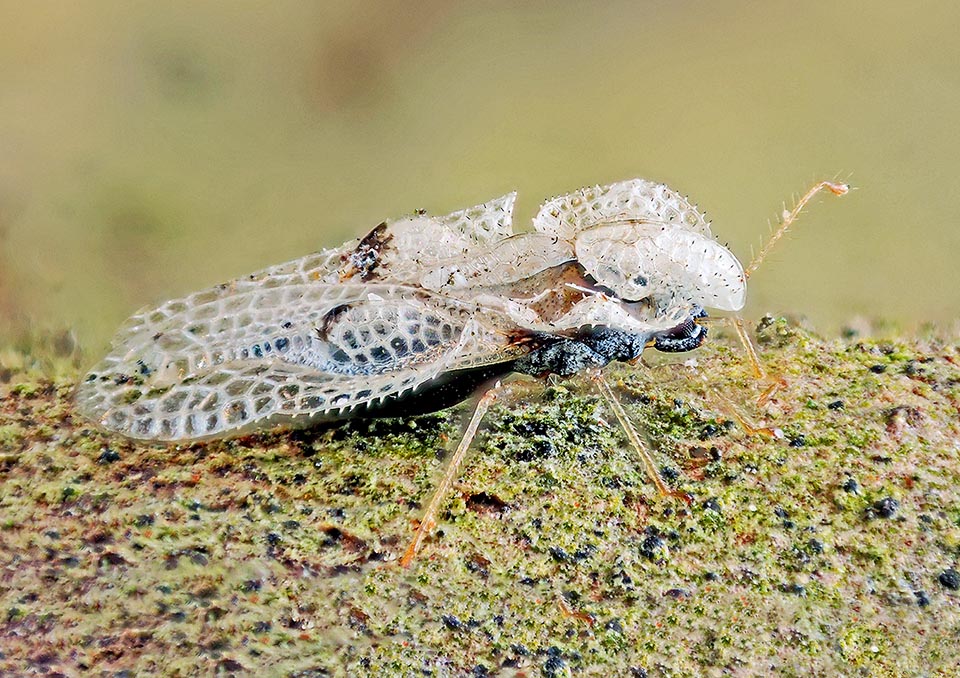
About 4 mm long, has a flat body, shiny black, covered by unusual, reticulated structures © Gilles San Martin
Zoogeography
Corythucha ciliata is a Nearctic species, native to North America where it is widespread in the eastern zone of the USA and of Canada.
Observed in 1964 in Italy, it’s nowadays diffused in a good part of Europe, from the Iberian Peninsula to Hungary and to Russia, as well as in Asia and Australia. Recently it has been reported in Argentina and Chile.
The capillary diffusion of the Phytomyza, called so because it pricks and sucks the plant tissues, is favoured by the large vehicles, mainly tarpaulin, that touch the crowns, or stop at traffic lights under infested plane trees.
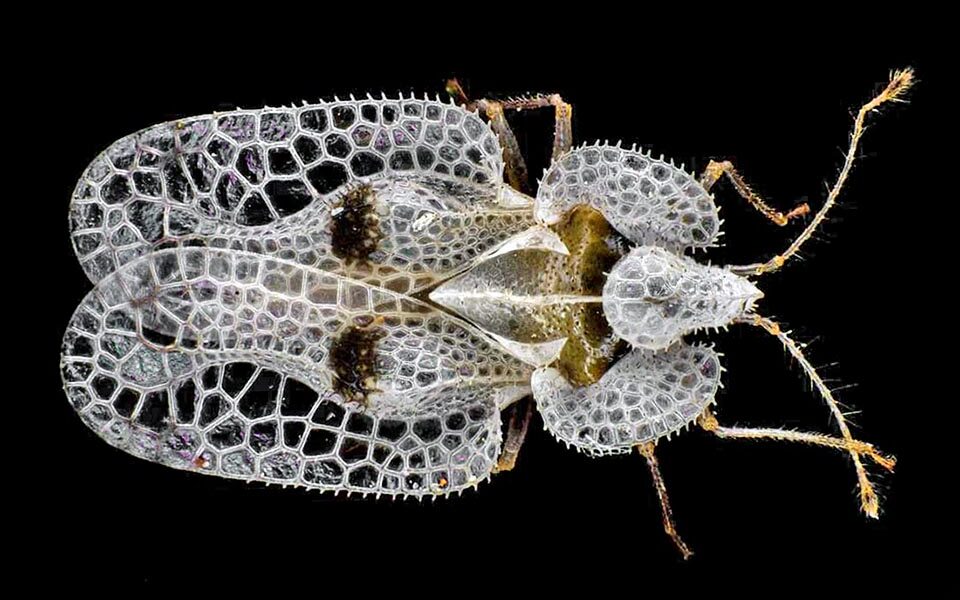
The wings, parchment-like, are sub quadrangular, with a more or less dark vesicle. The yellowish pronotum, with ample reticulated expansions, is equipped with a crest taller than the median keel. The two lateral expansions, called paranota, are well developed with a lattice having meshes smaller than those of the others © Sergio Aresi
The adults let themselves fall on these means of transport, and then take off on other plane trees even tens of kilometres far away. Because of this behaviour, the Platanus lace bug falls into the category of the so-called “hitchhikers” insects.
Ecology-Habitat
Corythucha ciliata lives almost exclusively on plants of the genus Platanus in particular on the Western plane (Platanus occidentalis) and hybrids, less infested is the Oriental plane (Platanus orientalis).
It has been reported also on other plants belonging to the genus Fraxinus and Broussonetia papyrifera.
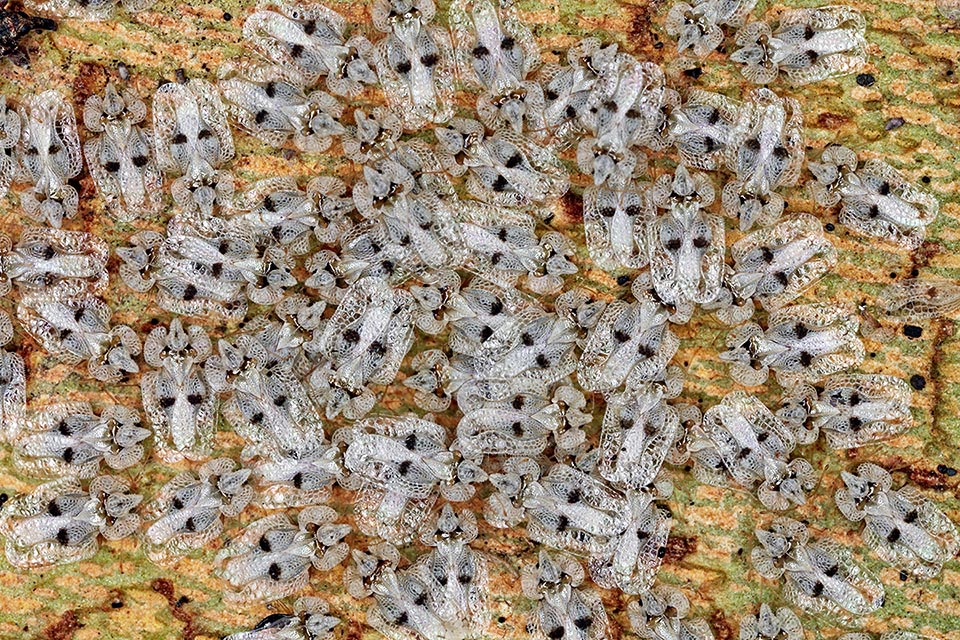
The adults, here surprised under the removed plaque of a plane tree, winter grouping under the rhytidome where they can bear even temperatures of -10 °C © Christian Hugues
The diet is plasmophage: all the active stages, with the buccal stylets, prick the leaves and suck the cytoplasmic contents of the cells of the palisade mesophyll and of the lacunous one, producing brown droppings. The seriously infested leaves get a chlorotic appearance, desiccate and fall down.
The alterations caused by adults in spring, but especially those caused by the juvenile stages, in summer and in autumn, emphasize with yellowings of the upper pagina, along the veins up to affect the entire foliar surface.
The juvenile stages of Corythucha ciliata are little mobile and tend to group together near the main veins of the lower pagina of the leaves.
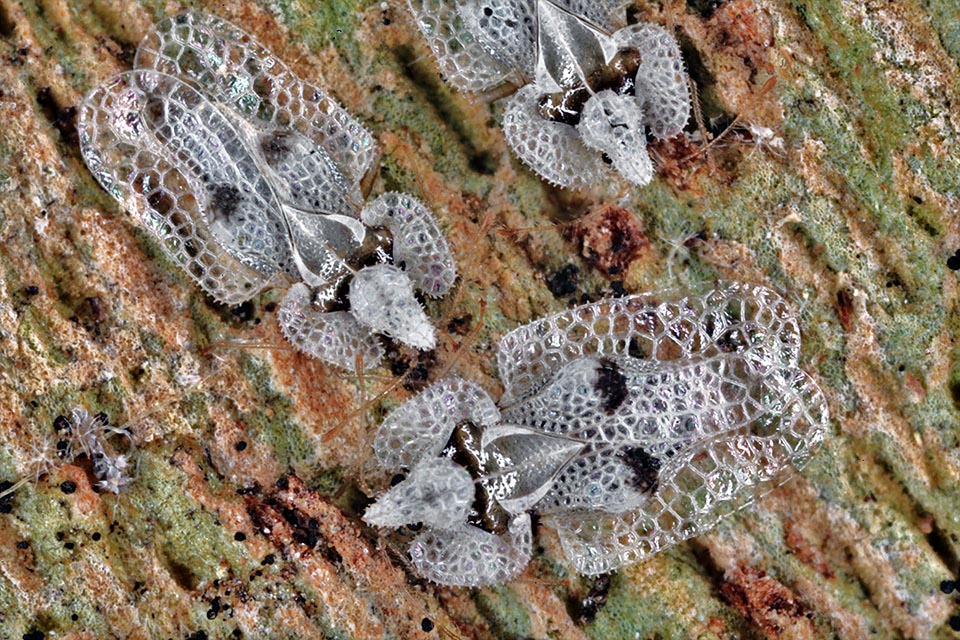
They come out from their shelter in April when appear the leaves that they parasitize until they wither sucking the humours © Christian Hugues
The adults perform short flights and move on the leaf from where they often fall landing on the passers-by to whom, with accidental bites, may cause allergic reactions or simple cutaneous rednesses.
Morphophysiology
The adults’ body of Corythucha ciliata is flat and about 4 mm long, of a bright black colour. The pronotum is yellowish with ample reticulated expansions and is equipped with a crest higher than the median keel. The two lateral expansions, called paranota, are well developed with a lattice with meshes smaller than the others.
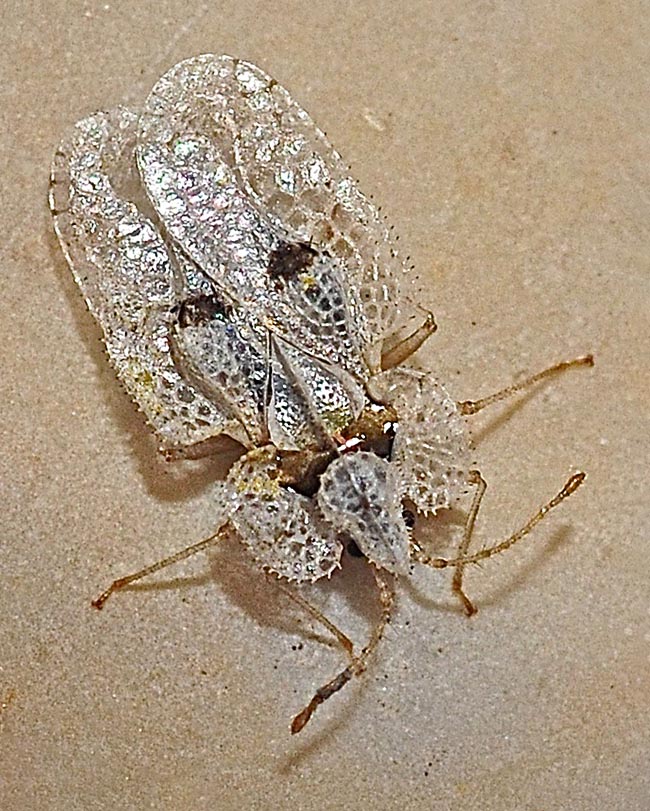
They prefer the plane trees but attack also the ash trees and the Broussomitia papyfera © Robert Combes
The wings with a sub quadrangular shape and of pergameneous consistency, have a basal vesicle, or ampulla, more or less dark.
The eggs, of glossy blackish colour with a small whitish collar at the apex, are oblong and measure about 0,5 mm.
The body of the juvenile stages displays along the edges and in various points of the back spines of two main types and are rather prominent.
The neanids just hatched are about 1 mm long, whitish, with yellow antennae and legs, later on they get darker.
The nymphs have dark grey bodies equipped with spines; during their three ages of development the alar outlines become more evident.
During the last nymphal stage, 3 mm long, the wing outlines reach the fifth abdominal segment.
The fore margin of the pronotum in correspondence to the median line is raised and extended a little forward whilst the hind margin is clearly triangular.
The lateral margins of the first three abdominal segments do not have spines.
Ethology-Reproductive Biology
Corythucha ciliata performs, usually, two annual generations in North and Central Europe, whilst in Sicily, where it has been observed in 1981, usually performs three of them.
The last generation adults, sexually immature, starting from mid-September, just before the physiological fall of the leaves, gradually migrate from the crown to the rhytidome plaques, or even inside buildings, where they spend the winter.
During the month of April, by the vegetative restart of the Plane trees, the surviving individuals move to the new leaves for feeding and, once the gonads are mature, after mating, the females, starting from; early May, lay about a hundred eggs on the lower pagina of the leaves, on the sides or at the bifurcation of the main veins, giving start to the first annual generation.
The embryonic development, depending on the environmental temperatures, lasts about 20 days.
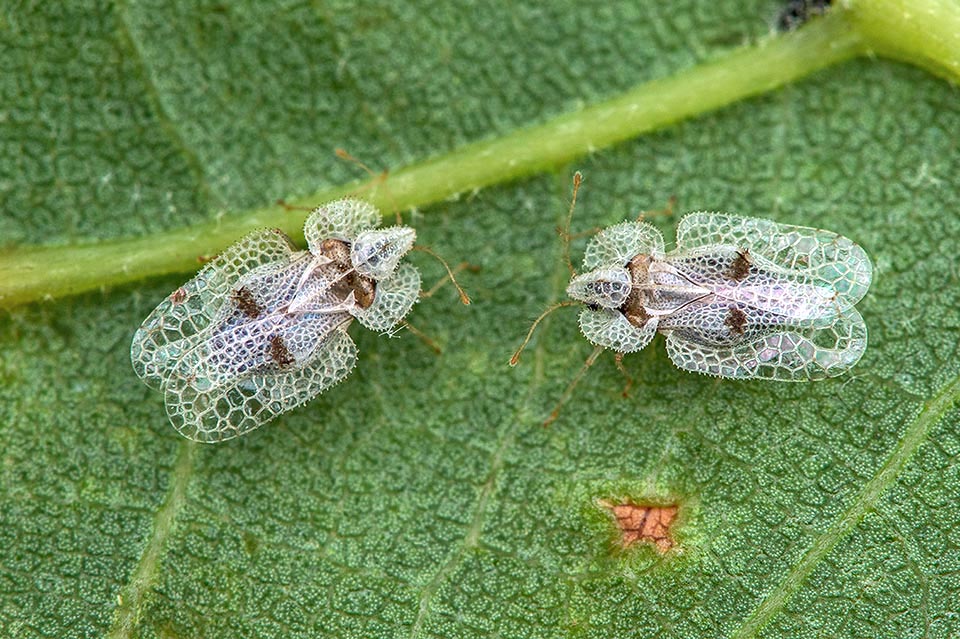
Here are two active adults. The eggs have just been laid in that dark small mass, top right. They perform 2-4 generations per year © Frank Deschandol
During their first age the neanids keep close to the empty chorions of the eggs; whilst the nymphs tend to move on the less populated leaves. The new adults appear by the end of June.
The second generation ends from late July to October. In such a period thanks to its high biotic potential, the Tingid reaches high densities of population that cause obvious alterations to the crown and a reduced woody growth but not the death of the plant. The third-generation adults are born from September to November.
Starting from early October the second and third generation of Corythucha ciliata gradually move into the winter shelters, where they are able to survive even at temperatures of -10 °C.
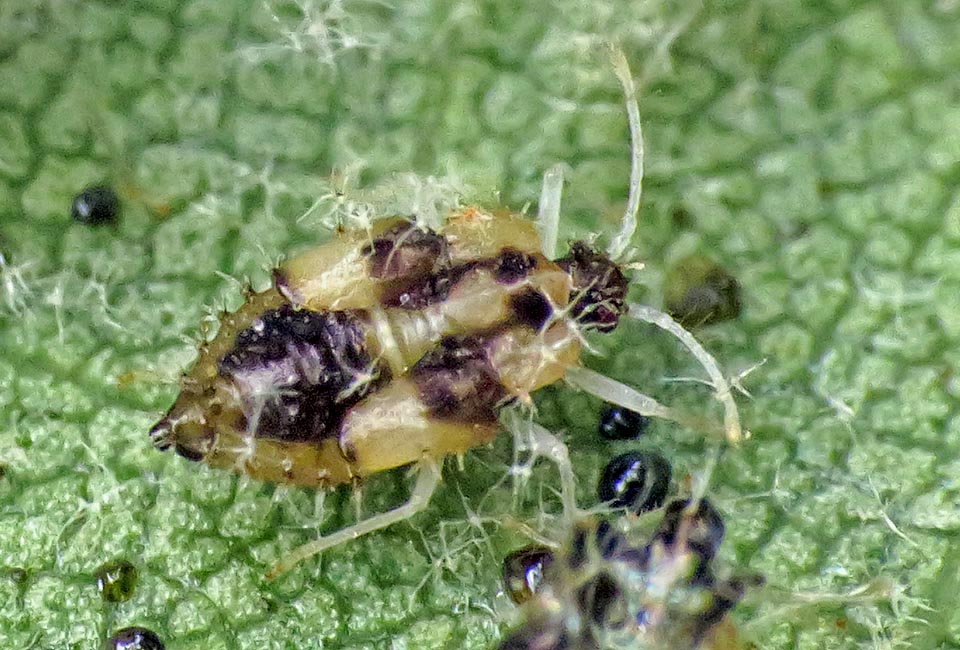
A nymph. The embryonic development, depending on the environmental temperatures, lasts about 120 days © Simon Oliver
In temperate environments and especially in the cities, where the artificial lightning makes the leaves on the plane trees to persist long, a fourth generation starts but rarely comes to an end, with the arrival of the low temperatures. In April, the adults leave their winter quarters and move to the new leaves of the plants.
Some Anthocorid Heteropterans of the genus Orius prey on the neanids of the Tingid. Only in some humid environments, the entomopathogenic fungus Beauveria bassiana (Blais. Criv) Vuil, manages to cause significant infections in the adults of the Tingid wintering under the rhytidome of the plane trees.
Synonyms
Tingis ciliata Say, 1831.
→ To appreciate the biodiversity of RHINCHOTA or HEMIPTERA click here.
